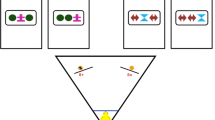Summary
Pigeons learned to discriminate a large number of bilateral symmetric and asymmetric visual patterns successively projected on the pecking-key of an operant conditioning chamber. Responses to the positive stimuli were reinforced according to a variable interval schedule. Once acquisition was complete generalization trials, involving sets of new stimuli, were instituted under extinction. The birds classified these novel test stimuli with high accuracy throughout, according to their symmetry or asymmetry. Their performance was not disturbed by sets of test stimuli whose geometrical style differed considerably from the training stimuli. Pigeons were even able to discriminate when only allowed the use of one eye. The generalization series were partly designed to test some classical symmetry recognition theories. None was found to be adequate. Subsidiary experiments suggested that most pigeons have a slight spontaneous preference for asymmetric patterns and that symmetry/asymmetry differences can aid pattern discrimination learning at an early stage. It is concluded that pigeons, much like humans, can discriminate bilaterally symmetric from non-symmetric visual forms in a concept-like, generalizing way. The ontogenetic and phylogenetic development of this competence is considered. A novel symmetry recognition hypothesis based on spatial frequency analysis and neuronal feature-detector considerations is proposed.
Similar content being viewed by others
References
Achim A, Corballis MC (1976) Mirror-image equivalence and the anterior commissure. Neuropsychol 15:475–478
Atkinson J, Campbell FW (1974) The effect of phase on the perception of compound gratings. Vision Res 14:159–162
Attneave F (1955) Symmetry, information and memory for patterns. Am J Psychol 68:209–222
Barlow HB, Reeves BC (1979) The versatility and absolute efficiency of detecting mirror symmetry in random dot displays. Vision Res 19:783–793
Bornstein MH, Ferdinandsen K, Gross CG (1981) Perception of symmetry in infancy. Develop Psychol 17:82–86
Corballis MC, Beale IL (1976) The psychology of left and right. Lawrence Erlbaum Associates, Hillsdale, NJ
Corballis MC, Roldan CE (1974) On the perception of symmetrical and repeated patterns. Percept Psychophys 16:136–142
Cowan WM, Adamson L, Powell TPS (1961) An experimental study of the avian visual system. J Anat 95:545–563
Cuénod M (1974) Commissural pathways in interhemispheric transfer of visual information in the pigeon. In: Schmitt FO, Worden FG (eds) The neurosciences, third study program. MIT Press, Cambridge, Ma
Curio E (1976) The ethology of predation. Springer, Berlin Heidelberg New York
Delius JD, Habers G (1978) Symmetry: Can pigeons conceptualize it? Behav Biol 22:336–342
DeValois R, DeValois KK (1980) Spatial vision. Ann Rev Psychol 31:309–341
Eisenman R, Gellens HK (1968) Preference for complexity-simplicity and symmetry-asymmetry. Percept Mot Skills 26:888–890
Gellermann LW (1933) Chance orders of alternating stimuli in visual discrimination experiments. J Genet Psychol 42:206–208
Herrnstein RJ, Loveland DH (1964) Complex visual concept in the pigeon. Science 146:549–551
Herrnstein RJ, Loveland DH, Cable C (1976) Natural concept in the pigeon. J Exp Psychol Anim Behav Process 2:258–302
Herrnstein RJ, DeVilliers PA (1980) Fish as a natural category for people and pigeons. Psychol Learn Motiv 14:59–95
Hollard VD, Delius JD (1982) Rotational invariance in visual pattern recognition by pigeons and humans. Science (in press)
Howe ES (1980) Effects of partial symmetry, exposure time and backward masking on judged goodness and reproduction of visual patterns. Quart J Exp Psychol 32:27–55
Jassik-Gerschenfeld D, Hardy O (1981) Single-cell response to bar-width and to sine-wave grating frequency in the pigeon optic tectum. Vision Res 21:745–747
Julesz B (1971) Foundations of cyclopean perception. University of Chicago Press Chicago
Julesz B, Chang JJ (1979) Symmetry perception and spatial-frequency channels. Perception 8:711–718
Lubow RE (1974) High-order concept formation in the pigeon. J Exp Anal Behav 21:475–483
Mello NK (1965) Interhemispheric reversal of mirror-image oblique lines following monocular training in pigeons. Science 148:252–254
Menne M, Curio E (1978) Untersuchungen zum Symmetriekonzept bei Kohlmeisen (Parus major L). Z Tierpsychol 47:299–322
Morgan MJ, Fitch MD, Holman JG, Lea SEG (1976) Pigeons learn the concept of an ‘A’. Perception 5:57–66
Palmer SE, Hemenway K (1978) Orientation and symmetry. Effects of multiple, rotational and near symmetries. J Exp Psychol Human Percept Perform 4:691–702
Pollen DA, Ronner SF (1981) Phase relationships between adjacent simple cells in the visual cortex. Science 212:1409–1411
Poole J, Lander DG (1971) The pigeon's concept of a pigeon. Psychon Sci 25:157–158
Rensch B (1958) Die Wirksamkeit ästhetischer Faktoren bei Wirbeltieren. Z Tierpsychol 15:447–461
Réperant J (1973) Nouvelles données sur les projections visuelles chez le pigeon (Columba livia). J Hirnforsch 14:151–187
Rosch EH (1973) Natural categories. Cognit Psychol 4:328–350
Seligman MEP (1970) On the generality of the laws of learning. Psychol Rev 77:406–418
Siegel RK, Honig WK (1970) Pigeon concept formation: Successive and simultaneous acquisition. J Exp Anal Behav 13:385–390
Szilagyi PG, Baird JC (1977) A quantitative approach to the study of visual symmetry. Percept Psychophys 22:287–292
Voneida TJ, Mello NK (1975) Interhemispheric projections in pigeon. Brain Behav Evol 11:91–108
Watanabe S (1979) Mirror image discrimination with each eye in pigeons. Physiol Behav 22:331–337
Weyl H (1952) Symmetry. Princeton University Press, Princeton
Author information
Authors and Affiliations
Rights and permissions
About this article
Cite this article
Delius, J.D., Nowak, B. Visual symmetry recognition by pigeons. Psychol. Res 44, 199–212 (1982). https://doi.org/10.1007/BF00308420
Received:
Issue Date:
DOI: https://doi.org/10.1007/BF00308420




